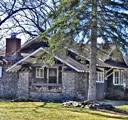
Arts and Crafts (1905 – 1930s)
From cozy bungalows to sprawling Prairie houses, many American homes were shaped by Craftsman ideas.
History:
During the 1880s, John Ruskin, William Morris, Philip Webb, and other English designers and thinkers launched the Arts and Crafts Movement, which celebrated handicrafts and encouraged the use of simple forms and natural materials. In the United States, two California brothers, Charles Sumner Greene and Henry Mather Green, began to design houses that combined Arts and Crafts ideas with a fascination for the simple wooden architecture of China and Japan.
The name “Craftsman” comes from the title of a popular magazine published by the famous furniture designer, Gustav Stickley, between 1901 and 1916. A true Craftsman house is one that is built according to plans published in Stickley’s magazine. But other magazines, pattern books, and mail order house catalogs began to publish plans for houses with Craftsman-like details. Soon the word “Craftsman” came to mean any house that expressed Arts and Crafts ideals, most especially the simple, economical, and extremely popular Bungalow.
A Craftsman house is often a Bungalow, but many other styles can have Arts and Crafts, or Craftsman features.
Features:
Wood, stone, or stucco siding
Low-pitched roof
Wide eaves with triangular brackets
Exposed roof rafters
Porch with thick square or round columns
Stone porch supports
Exterior chimney made with stone
Open floor plans; few hallways
Numerous windows
Some windows with stained or leaded glass
Beamed ceilings
Dark wood wainscoting and moldings
Built-in cabinets, shelves, and seating
Next: Bungalow